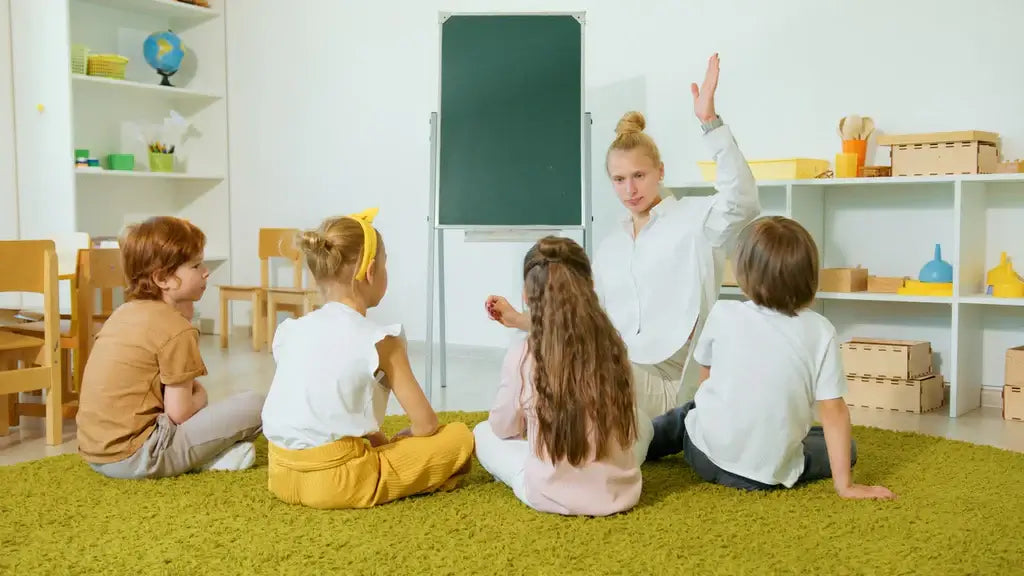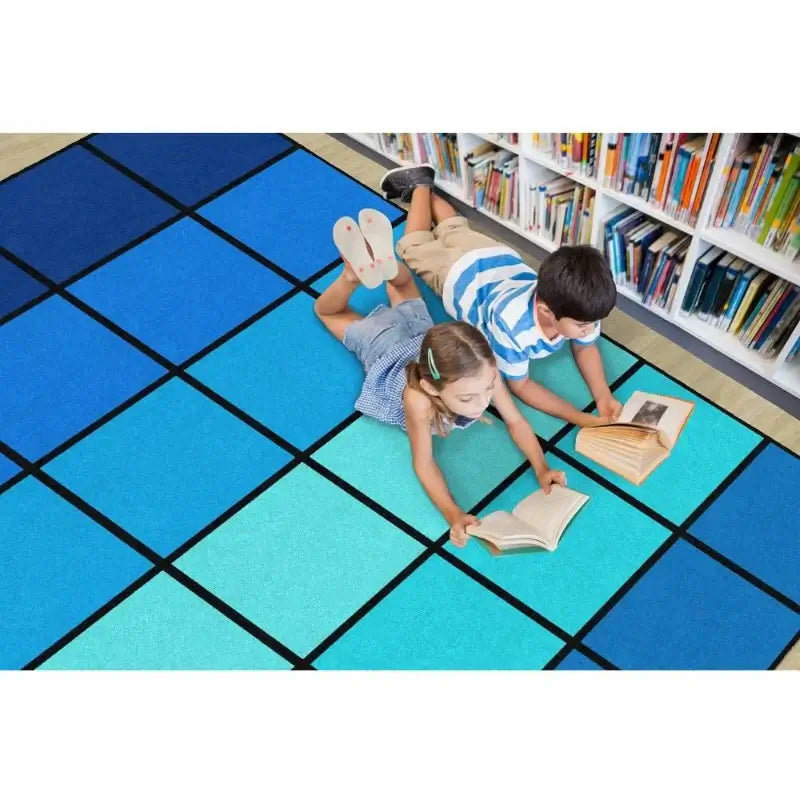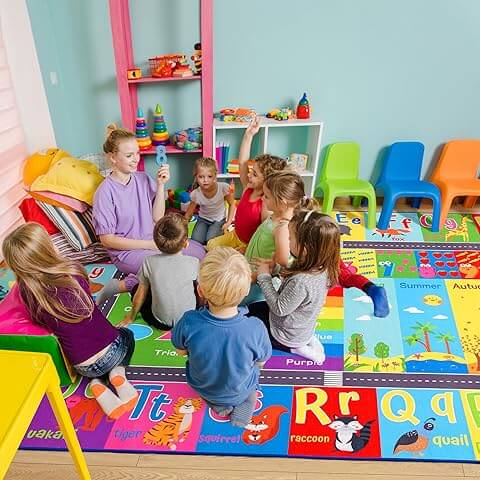Listen up, y'all! If you've ever watched a too-cool-for-school fifth grader try to maintain their "I'm bored" face while secretly being totally captivated by an awesome classroom setup, then you know exactly what I'm talking about. There's something downright magical about strategic classroom design zones that can transform even the most reluctant learners into eager participants.
And the secret weapon in this transformation? That humble rectangle on your classroom floor!
Carpet Magic: How Patterns Build Better Brains
Let's get real for a minute. Those themed classroom rugs aren't just pretty floor decorations—they're legitimate brain-building tools! Research shows that thoughtfully designed physical spaces can significantly impact cognitive development, and the right rug at the center of each zone amplifies this effect.
"I used to think classroom rugs were just for designating where kids should sit," admits Mr. Rodriguez, a veteran third-grade teacher. "Now I understand they're actually working overtime to develop spatial reasoning, pattern recognition, and even executive function!"
Let's break down how different carpet patterns secretly boost different kinds of intelligence:
Geometric Pattern Rugs: Math Minds in the Making
Those circles, squares, and triangles aren't just decorative—they're building mathematical thinking! When children interact with geometric pattern rugs, they're unconsciously absorbing concepts like:
- Spatial relationships (What's inside what? What's next to what?)
- Pattern recognition (What comes next in the sequence?)
- Symmetry and reflection (What happens if we fold this design in half?)
Mrs. Chen's second-graders don't just sit on their circular pattern rug—they use it: "During our morning meeting, I'll ask questions like 'Find a spot where three colors meet' or 'Sit in a blue triangle that's beside a yellow square.' They're practicing directional language, spatial reasoning, and descriptive vocabulary without realizing it's a math lesson!"
Map & Journey Rugs: Geographic Geniuses
Rugs featuring maps, roads, or pathways do heavy lifting for spatial intelligence. When kids play on map rugs, they're developing:
- Mental mapping abilities
- Directional awareness
- Sequential thinking
- Understanding of scale and distance
"My kindergartners love our town road rug," shares Ms. Williams. "They're constantly narrating elaborate stories about traveling from the grocery store to the library. I'll overhear them using phrases like 'Turn north at the intersection' or 'Continue past the hospital.' These are 5-year-olds developing geographic vocabulary through play!"
Alphabet & Number Rugs: Literacy Launch Pads
These classroom classics earn their popularity! Educational pattern rugs support:
- Symbol recognition
- Sequencing skills
- Phonemic awareness
- Numerical relationships
But the smartest teachers take it further than just "sit on the letter A." Mr. Jackson's approach with his first-graders is genius: "We play 'Sound Hopscotch' where kids jump to letters that make specific sounds. Or for math, they'll create 'human number sentences' by standing on numbers and operation symbols. The physical movement combined with the visual patterns creates multiple neural pathways for learning."
Creating Zones That Make Learning Irresistible
The secret to flexible learning spaces that actually work? Strategic rug placement! Here's how to set up zones that boost specific types of intelligence:
1. The Curiosity Corner: Where Questions Bloom
Every classroom needs a dedicated wonder zone—a special area where questions are celebrated and investigation is the goal.
- The Rug: Choose a science-themed rug with space motifs, nature elements, or scientific tools.
- The Setup: Surround it with magnifying glasses, question prompt cards, and fascinating specimens or photos.
- The Brain Boost: This zone develops observational skills, questioning abilities, and scientific thinking.
"My Curiosity Corner has become the most popular spot during free choice time," reports fourth-grade teacher Ms. Lopez. "The space-themed rug signals to students that this is where we wonder about big ideas. I've heard the most amazing philosophical discussions happen organically in this space!"
2. The Collaboration Station: Where Teams Thrive
Collaborative intelligence needs nurturing, and the right zone can make it happen!
- The Rug: Look for large circular rugs where groups can gather equally.
- The Setup: Add clipboards, chart paper, and role cards to structure group work.
- The Brain Boost: This zone develops communication skills, perspective-taking, and cooperative problem-solving.
"Even my most independent students get excited about group work now," shares Mr. Wilson. "There's something about that round rug that puts everyone on equal footing. The circular pattern subtly communicates that everyone's contribution matters."
3. The Creation Station: Where Imagination Soars
Creative intelligence flourishes in spaces designed for innovation!
- The Rug: Select abstract pattern rugs with swirls, splashes, or artistic designs.
- The Setup: Stock it with open-ended materials like blocks, art supplies, or building materials.
- The Brain Boost: This zone develops divergent thinking, aesthetic awareness, and innovation skills.
Third-grade teacher Ms. Garcia notes: "The swirling patterns on our creation zone rug seem to inspire more fluid thinking. When students are stuck, I'll suggest they trace a pattern on the rug with their finger to get their creative juices flowing again. Works like a charm!"
4. The Reflection Retreat: Where Thinking Deepens
In our go-go-go world, metacognitive intelligence needs dedicated space to grow.
- The Rug: Choose calming, simple patterns in soothing colors.
- The Setup: Add comfy pillows, journals, and thought-provoking prompts.
- The Brain Boost: This zone develops self-awareness, emotional intelligence, and metacognition.
"My fifth-graders used to groan when I mentioned reflection time," admits Mrs. Patel. "Now that we have our dedicated 'Thinking Spot' with its beautiful blue swirl rug, they actually look forward to it. The physical space signals a different kind of mental work."
Making Transitions Magical with Rug Routines
The most brilliant teachers know that classroom interest centers aren't just about the physical setup—they're about the routines that surround them. When you establish special transitions for moving between rug zones, you're actually building executive function skills!
Some rug transition magic we love:
- The Transformation Walk: Students "transform" into scientists/authors/mathematicians as they walk to specialized rug areas, changing their posture and focus.
- Pattern Pathways: Use tape or rope to create pathways between rug zones, with different movement patterns for each path (tip-toe, hop, giant steps).
- Zone Voices: Each rug zone has its own voice level expectation, clearly signaled by visual cues.
Fifth-grade teacher Mr. Thomas shares: "Moving between our rug zones has become a brain break and a focusing tool. The physical movement helps reset attention, and the consistent routines build valuable transition skills."
Real Talk: Carpet Intelligence for the "Cool Kids"
Let's address the elephant in the room—those too-cool-for-school upper elementary and middle schoolers who roll their eyes at anything that seems "babyish."
The trick? Modern classroom layouts that respect their maturity while still harnessing the power of defined zones:
- Opt for sophisticated patterns and color schemes
- Use terminology that honors their age ("Design Lab" instead of "Creation Station")
- Involve them in creating zone purposes and rules
- Make connections to real-world work environments
"My sixth-graders helped design our classroom zones," shares Ms. Rivera. "They researched how tech companies and design firms set up collaborative spaces, then created proposals for our room. They were invested because they felt respected in the process."
The "Too Cool" Kid Test: Signs Your Rug Zones Are Working
How do you know when your student-centered spaces are truly effective? When even your most reluctant learners can't resist engaging! Look for these telltale signs:
- The habitually distracted student who suddenly spends focused time in your puzzle zone
- The "I hate reading" kid who voluntarily heads to the book nook during free choice
- The social butterfly who demonstrates unexpected leadership in your collaboration station
- The fidgety child who finds calm in your sensory-friendly quiet zone
"My most resistant student, Jake, would find any excuse to avoid writing," remembers Mrs. Washington. "Then I created our 'Author's Circle' with a special round rug and decorative pillows. I nearly fell over when he asked if he could take his writing workshop there! Something about that dedicated space legitimized the work for him."
Intelligence-Boosting Rug Activities That'll Make Your Teacher Heart Sing
Ready for some classroom engagement strategies that leverage your rug zones for maximum brain benefit? Try these teacher-tested favorites:
Pattern Predict & Extend
Turn geometric rug patterns into mathematical challenges:
- "If this pattern continued, what would come next beyond the edge of the rug?"
- "Create your own pattern using manipulatives that follows the same rule as this section of our rug."
Map Adventures
Use journey rugs to develop storytelling and planning:
- Create character tokens that "travel" through the map rug, facing challenges at different points
- Plan the most efficient route between two locations, explaining your reasoning
Vocabulary Islands
Transform any patterned rug into a word-learning powerhouse:
- Assign different vocabulary words to different sections of the rug
- Students move to the section that answers your question ("Move to the word that means 'to look at something carefully'")
Emotional Intelligence Check-Ins
Use colored rug sections as emotion indicators:
- "Find a rug color that matches your mood today."
- "Sit in a spot that shows how you felt during our class discussion."
The Science Behind the Magic
Lest you think all this rug talk is just fluff, there's solid science backing up the power of classroom mood boosters like strategic zone design:
- Physical movement enhances cognitive processing
- Visual anchors support memory formation
- Defined spaces help students self-regulate
- Pattern recognition builds neural pathways
- Environmental cues trigger specific learning behaviors
As Dr. Rodriguez, educational psychologist, explains: "The physical environment acts as a 'third teacher' in the classroom. When teachers thoughtfully design spaces with specific learning goals in mind, they're essentially programming the room to facilitate certain types of thinking and behavior."
Your Turn to Create Carpet Magic!
Whether you're setting up your classroom for the first time or refreshing a tired layout, intentional rug zones can transform both your space and your students' learning experience.
Browse our full collection of classroom design zone rugs and imagine the possibilities for your own magical learning environment!
Remember, y'all—we're not just decorating floors; we're building brains, one carefully placed rug at a time!








Leave a comment
This site is protected by hCaptcha and the hCaptcha Privacy Policy and Terms of Service apply.